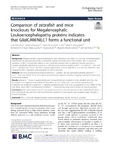Mostrar o rexistro simple do ítem
Comparison of zebrafish and mice knockouts for Megalencephalic Leukoencephalopathy proteins indicates that GlialCAM/MLC1 forms a functional unit
| dc.contributor.author | Pérez-Rius, Carla | |
| dc.contributor.author | Folgueira, Mónica | |
| dc.contributor.author | Elorza-Vidal, Xabier | |
| dc.contributor.author | Alia, A. | |
| dc.contributor.author | Hoegg-Beiler, Maja B. | |
| dc.contributor.author | Eeza, Muhamed N. H. | |
| dc.contributor.author | Díaz, María Luz | |
| dc.contributor.author | Nunes, Virginia | |
| dc.contributor.author | Barrallo-Gimeno, Alejandro | |
| dc.contributor.author | Estévez, Raúl | |
| dc.date.accessioned | 2019-12-27T12:23:54Z | |
| dc.date.available | 2019-12-27T12:23:54Z | |
| dc.date.issued | 2019-11-21 | |
| dc.identifier.citation | Pérez-Rius, C., Folgueira, M., Elorza-Vidal, X. et al. Comparison of zebrafish and mice knockouts for Megalencephalic Leukoencephalopathy proteins indicates that GlialCAM/MLC1 forms a functional unit. Orphanet J Rare Dis 14, 268 (2019) doi:10.1186/s13023-019-1248-5 | es_ES |
| dc.identifier.issn | 1750-1172 | |
| dc.identifier.uri | http://hdl.handle.net/2183/24552 | |
| dc.description.abstract | [Abstract] Background: Megalencephalic Leukoencephalopathy with subcortical Cysts (MLC) is a rare type of leukodystrophy characterized by astrocyte and myelin vacuolization, epilepsy and early-onset macrocephaly. MLC is caused by mutations in MLC1 or GLIALCAM, coding for two membrane proteins with an unknown function that form a complex specifically expressed in astrocytes at cell-cell junctions. Recent studies in Mlc1−/− or Glialcam−/− mice and mlc1−/− zebrafish have shown that MLC1 regulates glial surface levels of GlialCAM in vivo and that GlialCAM is also required for MLC1 expression and localization at cell-cell junctions. Methods: We have generated and analysed glialcama−/− zebrafish. We also generated zebrafish glialcama−/− mlc1−/− and mice double KO for both genes and performed magnetic resonance imaging, histological studies and biochemical analyses. Results: glialcama−/− shows megalencephaly and increased fluid accumulation. In both zebrafish and mice, this phenotype is not aggravated by additional elimination of mlc1. Unlike mice, mlc1 protein expression and localization are unaltered in glialcama−/− zebrafish, possibly because there is an up-regulation of mlc1 mRNA. In line with these results, MLC1 overexpressed in Glialcam−/− mouse primary astrocytes is located at cell-cell junctions. Conclusions: This work indicates that the two proteins involved in the pathogenesis of MLC, GlialCAM and MLC1, form a functional unit, and thus, that loss-of-function mutations in these genes cause leukodystrophy through a common pathway. | es_ES |
| dc.description.sponsorship | Ministerio de Ciencia e Innovación; SAF2015–70377 | es_ES |
| dc.description.sponsorship | Ministerio de Ciencia e Innovación; RTI2018–093493-B-I00 | es_ES |
| dc.description.sponsorship | Generalitat de Catalunya; SGR2014–1178 | es_ES |
| dc.description.sponsorship | Generalitat de Catalunya; SGR014–2016 | es_ES |
| dc.description.sponsorship | Instituto de Salud Carlos III; PI16/00267-R-Feder | es_ES |
| dc.language.iso | eng | es_ES |
| dc.publisher | BMC | es_ES |
| dc.relation.uri | https://doi.org/10.1186/s13023-019-1248-5 | es_ES |
| dc.rights | Atribución 3.0 España | es_ES |
| dc.rights.uri | http://creativecommons.org/licenses/by/3.0/es/ | * |
| dc.subject | MLC1 | es_ES |
| dc.subject | GLIALCAM | es_ES |
| dc.subject | Megalencephalic leukoencephalopathy | es_ES |
| dc.subject | Myelin | es_ES |
| dc.subject | Astrocyte | es_ES |
| dc.subject | Zebrafish | es_ES |
| dc.title | Comparison of zebrafish and mice knockouts for Megalencephalic Leukoencephalopathy proteins indicates that GlialCAM/MLC1 forms a functional unit | es_ES |
| dc.type | info:eu-repo/semantics/article | es_ES |
| dc.rights.access | info:eu-repo/semantics/openAccess | es_ES |
| UDC.journalTitle | Orphanet Journal of Rare Diseases | es_ES |
| UDC.volume | 14 | es_ES |
| UDC.startPage | 268 | es_ES |






